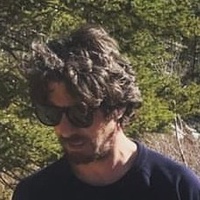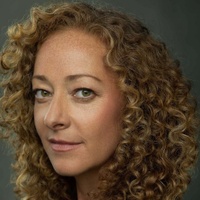On letting the world be your studio
Prelude
María Magdalena Campos-Pons is a Cuban-born visual artist. Campos-Pons works primarily in photography, performance, audiovisual media, and sculpture. She grew up on a sugar plantation in La Vega, Cuba in a family with Nigerian, Hispanic, and Chinese roots and her artistic practice is deeply influenced by her polyglot heritage. Her autobiographical work moves through themes of history, memory, gender, and religion as they inform one’s identity. She has gained an international reputation as an exponent of the New Cuban Art movement that arose in opposition to Communist repression on the island. She currently teaches drawing, performance, and installation at Vanderbilt University. In 2019 she is serving as artist-curator for the Havana Art Biennial in Cuba.
Conversation
On letting the world be your studio
Visual artist María Magdalena Campos-Pons on reconsidering the idea of a studio, working with whatever is around you, and why teaching remains a vital, creative act.
As told to T. Cole Rachel, 2141 words.
Tags: Art, Education, Mentorship, Time management, Process, Education.
Your work involves many different kinds of materials. Do you have a designated studio practice, or a regimented way that you like to work?
I work with many different materials but i think that if you follow the lineage of my work, I go back and forth and return to some of the same places that I started. I do installation and I do performance and I do visual work, and I stream between the spaces among them. I never had a large studio or a studio with 10 assistants. It has been primarily been just myself; for some work I bring in an outside assistant, but it has always been about my own dexterity.
I am working every day little by little, working and thinking about performance and video work. I draw, I take notes, I take images with my camera and my phone. I take notes even as I’m teaching. All of this is a way to gather material. I consider myself disciplined and structured about this process of methodology, carefully structuring the way I work in order to get all my work done. I am working all the time. I don’t take vacations. I don’t think that I’ve taken a vacation in 30 years, possibly. I also don’t think that that is brave or an example to be followed, that is just the way that I am and how I’ve been able to build the work that I have produced so far.
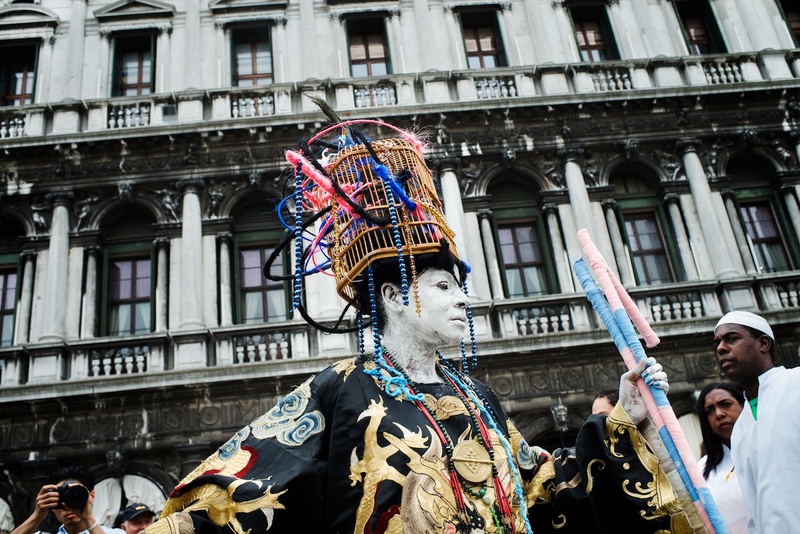
María Magdalena Campos-Pons, performance, 2013, Cuban Pavillion, Venice Biennale, San Marco, Venice, Italy
When you are producing lots of different kinds of work as well as teaching, how do you strike a balance?
When I was very young and I had very few resources, I discovered that I needed to depend very much on my own agency, and one of the things that I came up with at that time was that I could always find a way to work within my scale. My scale meaning my size, my body. I would still be able to accomplish things larger than my scale. One of the more interesting things was when I become a mother and I needed to take care of my child and play with him. He was playing with Legos and blocks. I was always thinking about what he built with the blocks. That was very important for me. I decided that I could work like him. I could build big things out of very small parts.
If you look at my work carefully, all the work I have done, I’m like a little kid putting things together. I don’t have a big studio or something like that. And money, I’m sometimes short for that as well. But I have managed to do things that are large in scale because they are like accumulations, or assembled gestures put together in this idea of building with blocks. Building with something that is small, but when it’s repeated or accumulated, it takes on another scale.
It also has to do with portability, because there was a time in my practice in which I didn’t have anybody who would pay for moving my work. They’d say, “Come! We have an opportunity to do an exhibition.” And I would put the entire thing in a suitcase. The entire exhibit. Some of those pieces are in museums now and they are quite fantastic, I think, but they were made with that kind of urgency—that I could carry them around by myself.
That kind of response and necessity never abandoned me. I am still interested in working from the same place, with the same kind of parameters. That may be a condition of, I don’t know, my upbringing? Who knows. As I said, I have never had a practice with many assistants in the studio. I have people who work with me and help me sometimes, but I never really had a huge team. My space for a studio has been always moderate enough, but I had the privilege to be an artist in residency at the Robert Rauschenberg Foundation in 2016 and it was… well, I cannot tell you how that was for me.
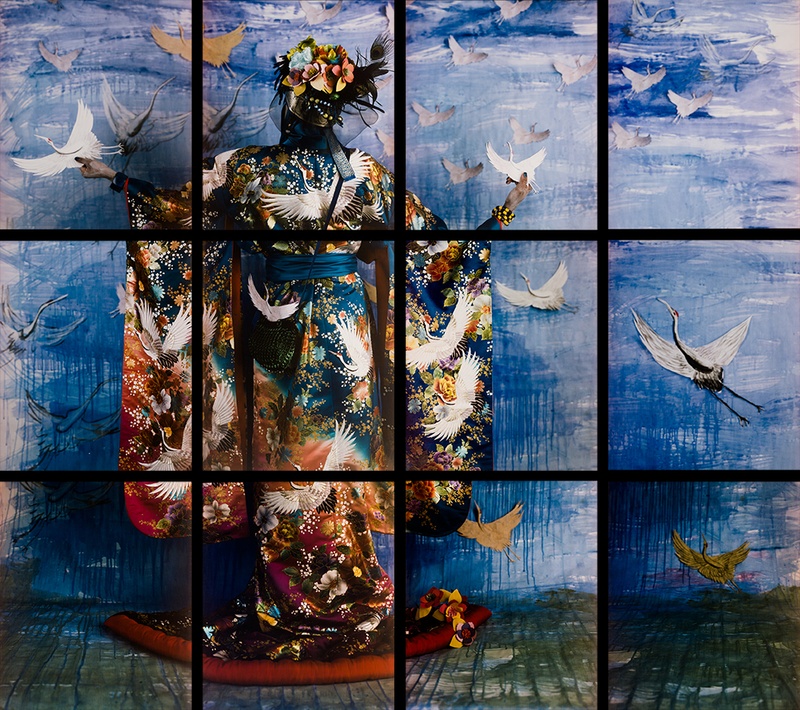
María Magdalena Campos-Pons, El Mensajero, 2011, Composition of 12 Polaroid Polacolor Pro 24 x 20 photograph, 24 x 20 inches each(60.7 x 50.8 cm each), 72 x 80 inches (182.9 x 203.2 cm)
One of the gentlemen who used to work with Rauschenberg, he changed my name and he called me Magdalicious, because I produced so much work there. For me, being in a huge studio was like being a kid in a toy store. It is unbelievable to have this huge table, five meters by two meters, and then you have seven of them in the room. How are you not gonna go crazy? You’re gonna do amazing work. So I did an incredible amount of work there.
When I have those kinds of opportunities, it is amazing. For me that is a moment of absolutely not being distracted. I have absolute attention only for the work. It’s like if you are making a piece of music and you get lost in the moment of the crescendo. I make new notes day by day. Every day it’s a new note, and then there is this moment in which I just put it all together and it’s, I don’t know, a rhapsody. Whatever it is. Something. It is music.
Teaching is learning for me, so I never see teaching as something that takes my energy or takes all my time. It requires both energy and time, but as somebody who cares about it, I don’t mind. I am a very good teacher. I get amazing results with my students. I am proud of that, and I think it’s because I had fantastic teachers myself.
I come from the school in which teaching is art making, too. The pedagogy is a way to structure your making and your thinking and your practice. So when I practice teaching, I am making things in my mind. I am teaching with a lot of feeling. I am teaching what I want to teach. My students are learning with me what they want from me. So that is very different from being clustered in an institution or academic situation in which you are not happy, or you are drained of your energy or your time. That is not the case. That’s not what I am doing. It’s invigorating to be with young thinkers, because they are hungry and they eat from you. But I am still hungry, too, so I eat along with them.
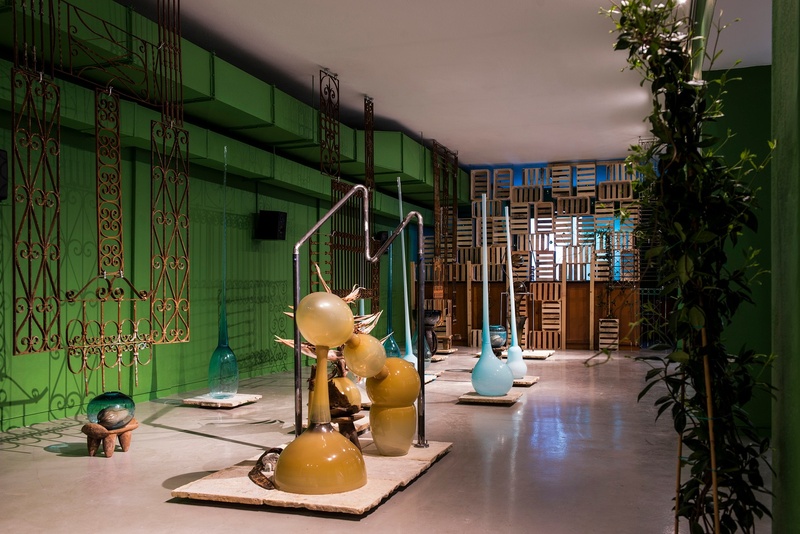
María Magdalena Campos-Pons: If I Were A Poet, installation view, Gallery Wendi Norris Offsite, 649 Mason Street, San Francisco, CA, January 11 - 28, 2018, photography: Maciek Janicki
For many artists, there is the sense that teaching is simply a means to an end, something they need to do to make a living but would leave behind if they could.
No. For many years I made more money selling my art than teaching. You could say the teaching was diminishing the time I could sell my work, but it was not. I have a passion for teaching and I feel that teachers are very needed. I encountered bad teachers, so I consider myself to be a good one. I want to stay there to save some people.
Can you work anywhere? What do you need from a studio?
That is an interesting question: What is a studio? Now, as I grow older, I have more input into that. I think that a studio is anything. We cannot follow only the idea of the white cube as a studio. The world is my studio. On my palette are so many things that I can play with. It’s a balance. I don’t think that we still need the idea that somebody needs to lock themselves in a box to not be disturbed in order to produce something amazing and beautiful.
Is there any standard, go-to advice that you’d give to young artists who are trying to figure out how to move out into the world?
Oh, I give them a lot. I teach my class the way I live. I read poetry to my students in the morning. I play music to them. I introduce them to people they have never heard of. I make them read books. I mean the last studio class that I taught, I made my students read three books by Toni Morrison. I made them see Toni Morrison lecture at Harvard. I tell my students—all my students, always—you need to go to bed every night with somebody. Before you go to sleep, you need to go to bed with somebody. And they look at me with big eyes, crazy. And I say, “I mean, who do you read before you go to bed? Who do you take with you in your mind before you go to bed?” I tell them to read every night, to put something good into their mind before they go to sleep.
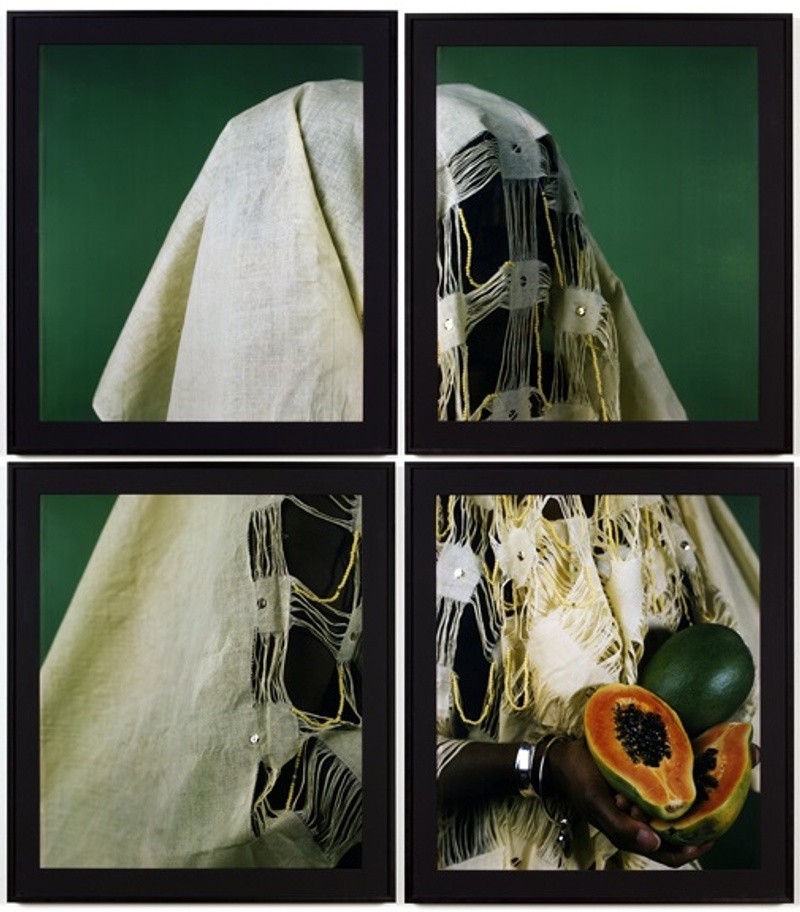
Bin Bin Lady, The Papaya, Polaroid Polacolor Pro, 24 x 20 inches each (50.8 x 61 cm), 48 x 40 inches (121.92 x 101.6 cm)
So that is really a big deal, and I insist with my students about reading and about the expanding the vision they have for their practice. I force them to visualize when they listen to music. To read poetry. To make poetry. To make music. No matter what I’m teaching—painting, installation—it’s the same thing. I have great friendships with some of my students. I have very successful students. I make all of them keep diaries and I force them to take notes in my class. I require them to be there every day. If they study with me, they need to be in the class. It’s not optional. So they are there, and it’s amazing how they are present and how they engage and relate. I talk to them about being gluttons, but in a good way. They should consume everything that is in their path. That is the way to their greatness. That kind of gluttony. That kind of insatiable desire. Not to be famous necessarily, and not to be successful, but to learn and to do something important to oneself.
I always tell my students in every class: We are here because of art. We are sitting in this room talking and sharing because of art, but not just because this is as an art class. We are here as humans because art is our safe keeper. Our destiny keeper. The landscape of our journey. We are here as a result of that. We draw to survive. We paint to survive. We paint to eat. And that gives us the energy to keep moving. We need to imagine where we are before we become something new, and that is only through art. This is what it is. Now we just dream what it could be… and all the windows are open.
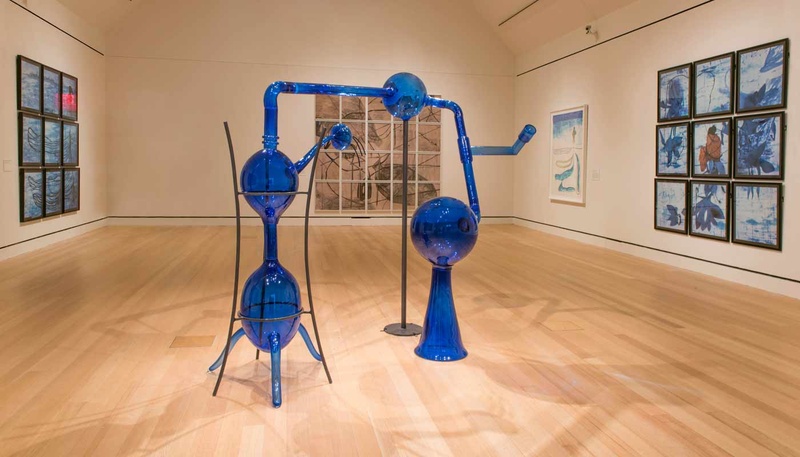
María Magdalena Campos-Pons: Alchemy of the Soul: Maria Magdalena Campos-Pons, installation view, Peabody Essex Museum, Salem, MA, January 9 — April 3, 2016
María Magdalena Campos-Pons recommends:
Five things I would recommend to a friend:
- a good massage if under stress
- dance with Cuban music
- connect with her spiritual side
- art in all possible forms
- outdoor running
Works that have inspired me:
- Clara Porset Designs
- Lygia Clark Performances
- Remedios Varo Painting “The Creation of the Birds“
- Andrei Tarkovsky Films
- Amos Tutuola’s The Palm-Wine Drinkard
- Marcel Duchamp’s “The Large Glass“
Things you like to do (besides my work):
- Gardening
- Cooking and setting a table for friends
- Meditation
- listening to live classical music
Things I love:
- I love Italy, the entire country is a garden
- A seat by the ocean and having grilled fish in Dakar
- Sunrises in Captiva, Sunsets in the Acropolis—those are healing hours
- Fall in Paris
- Bahía de Matanzas
Things I return to again and again:
- the Vatican in Rome, Galleria Borghese, la Marrana Arte Ambientale, the Met, Arvo Pärt, Chinua Achebe, Rilke, ISA Havana
- Name
- María Magdalena Campos-Pons
- Vocation
- Visual artist
Some Things
Pagination
